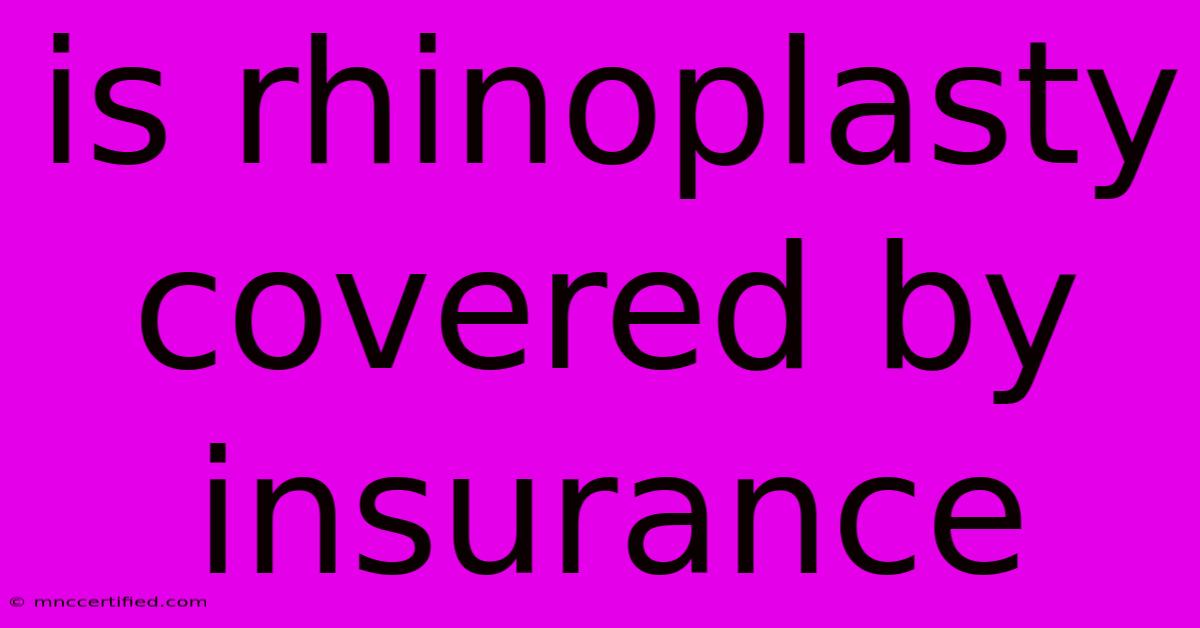Is Rhinoplasty Covered By Insurance

Table of Contents
Is Rhinoplasty Covered by Insurance? A Comprehensive Guide
Rhinoplasty, commonly known as a nose job, is a surgical procedure that reshapes the nose. It can address both functional and aesthetic concerns, improving breathing issues, correcting deformities, and enhancing facial harmony. While many people consider rhinoplasty, a common question arises: is rhinoplasty covered by insurance?
The short answer is it depends. Insurance coverage for rhinoplasty varies significantly depending on several factors, including:
- The reason for the procedure: Insurance companies typically cover rhinoplasty when it's medically necessary to address breathing difficulties, such as a deviated septum or nasal obstruction.
- Your insurance plan: Different insurance plans have varying levels of coverage for cosmetic procedures. Some plans may cover rhinoplasty if it's medically necessary, while others may not cover it at all.
- Your location: Coverage policies can vary based on your state and the specific insurance provider.
When is Rhinoplasty Covered by Insurance?
Insurance companies generally consider rhinoplasty medically necessary when it addresses the following:
- Breathing problems: If your nasal structure is blocking airflow, resulting in chronic sinusitis, snoring, or sleep apnea, your insurance may cover the surgery.
- Injuries: Rhinoplasty may be covered if it's necessary to repair a broken nose or other nasal injuries.
- Congenital defects: If you have a birth defect affecting your nasal structure, your insurance might cover the procedure.
- Tumors: Rhinoplasty may be covered to remove tumors or polyps that affect your nasal passages.
When is Rhinoplasty Not Covered by Insurance?
Insurance companies usually do not cover rhinoplasty for purely cosmetic reasons. This includes procedures done to:
- Change the shape or size of the nose: If your goal is to alter the appearance of your nose for aesthetic purposes, your insurance likely won't cover it.
- Improve facial symmetry: Rhinoplasty solely for improving facial balance or proportions is generally not covered.
- Enhance self-esteem: While rhinoplasty can boost confidence, insurance companies don't consider it a valid medical reason for coverage.
How to Maximize Your Chances of Coverage
While there's no guarantee of insurance coverage for rhinoplasty, you can take steps to improve your chances:
- Consult your doctor: Discuss your concerns and the potential benefits of rhinoplasty with your primary care physician. They can help determine if your case meets medical necessity criteria.
- Obtain a referral: Get a referral from your doctor to a qualified plastic surgeon specializing in rhinoplasty. They can provide documentation outlining the medical necessity of the procedure.
- Gather evidence: Collect medical records, previous treatment records, and any other evidence demonstrating the impact of your nasal issues on your health and well-being.
- Contact your insurance provider: Call your insurance company directly to inquire about coverage for rhinoplasty. Ask about specific requirements and documentation needed.
Alternative Payment Options for Rhinoplasty
If your insurance doesn't cover rhinoplasty or if you're pursuing the procedure for cosmetic reasons, consider these options:
- Financing plans: Many plastic surgeons offer financing options through medical financing companies.
- Saving up: Set a budget and save up for the cost of the procedure over time.
- Medical tourism: Explore the possibility of having rhinoplasty done in countries with lower medical costs.
Conclusion
Whether or not rhinoplasty is covered by insurance is a complex issue. By understanding the factors that influence coverage and taking steps to maximize your chances, you can make informed decisions regarding your treatment options. Remember to prioritize your health and consult with your doctor and insurance provider to determine the best path for you.

Thank you for visiting our website wich cover about Is Rhinoplasty Covered By Insurance. We hope the information provided has been useful to you. Feel free to contact us if you have any questions or need further assistance. See you next time and dont miss to bookmark.
Featured Posts
-
Veterans Day 2024 In Texas Business Hours
Nov 12, 2024
-
Trump Appoints Homan Miller To Key Border Roles
Nov 12, 2024
-
Costa Rica Citizenship By Investment
Nov 12, 2024
-
Megan Fox And Mgk Welcome First Baby
Nov 12, 2024
-
Top Scorers Out Barcelona Offense Faces Test
Nov 12, 2024